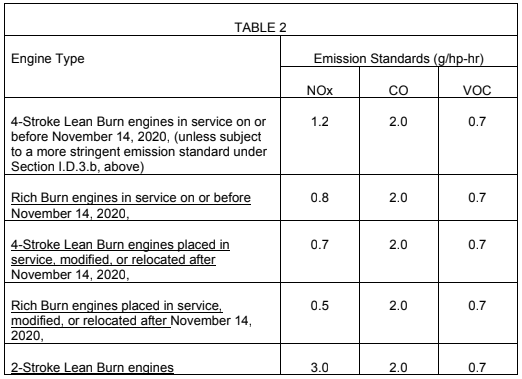What are the notification and reporting requirements?
By May 1, 2021, operators must submit a list of their natural gas fired RICE ≥1,000 hp placed in service on or before November 14, 2020 along with additional information to the Division.
Operators will also be required to submit annual reports by May 1st, beginning in 2022, containing information regarding required performance testing and details of engines that are applicable to the rule.
What if I want to make my own plan?
Good news – you can! There is an option for an Alternative Company-Wide Compliance Plan that operators can choose to use, so long as the overall fleet-wide NOx emission reductions are the same or greater than what would be achieved under the normal rule provisions. in order to use the company-wide compliance plan, owners and operators must have at least five applicable engines that would require additional controls to meet the emission standards in Table 2 and must submit their compliance plan to the Division on or before May 1, 2021. The compliance plan must outline all applicable engines, the most stringent emission standards, and the company’s plan to reduce emissions from their fleet of natural gas fired engines ≥1,000 hp. More information on this Alternative Company-Wide Compliance Plan can be found in Section I.D.5.c. of Regulation 7 Part E.
Oil and Gas Air Quality Monitoring (Regulation 7, Part D, Section VI.C.)
Beginning on or after May 1, 2021, owners and operators must monitor air quality during pre- and early-production operations. This includes monitoring air quality for at least ten days prior to “pre-production operations”, during all pre-production operations, and for at least six months post well-producing activity. Pre-production operations are defined as “drilling through the hydrocarbon bearing zones, hydraulic fracturing or refracturing, drill-out, and flowback of an oil and/or natural gas well,”.
Operators must submit their monitoring plan to nearby local governments and the Division at least sixty days prior to beginning the monitoring. The Division must approve the plan prior to commencing activities. In addition, monthly records must include the air quality monitoring plan, monthly report data, activity logs, raw monitor data, and meteorological data on site for up to one year after each monthly report. Monthly reports will be due to the Division by “the last day of the month following the previous month of monitoring” and will be made publicly available on the Division’s website. See Section VI.C.1. for more details regarding pre- and early-production air quality monitoring.
Flowback Vessel Control Strategy (Regulation 7, Part D, Section VI.D.)
Owners and operators are now required to control emissions from flowback vessels beginning on or after May 1, 2021. The vessels must be enclosed and are also required to be inspected daily to ensure they are vapor-tight. In addition, operators must use a tank measurement system to “determine the quantity of liquids in the flowback vessel(s)” meaning that no manual gauging of liquid in the flowback tank is allowed.
Class II Disposal Well Facilities
The AQCC has expanded control requirements for storage tanks at class II disposal well facilities and to loadout of hydrocarbon liquids at those facilities where VOC emissions are greater than or equal to two tons per year. Facilities that are constructed or modified on or after January 1, 2021 must control these emission sources at commencement of operation. For all other facilities that were constructed prior to the January 1st deadline, loadout must be controlled by May 1, 2021.
That was a lot of information
It was. Do not hesitate to contact us for further information on how these rule changes may impact you and your company. We are here to help your business stay in compliance. More information can be found within Regulation 7 and on the CDPHE’s website.



